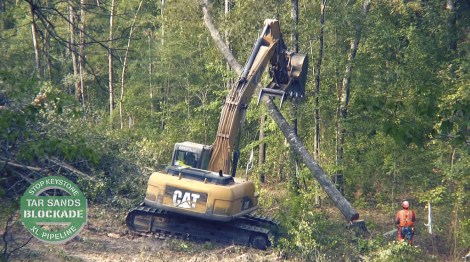TransCanada, the company that would like to build a large pipeline carrying toxic oil from the Canadian border to Texas, got pretty excited yesterday when the governor of Nebraska removed a key obstacle to the project. Very excited. So excited that the public relations team forgot how to use email.

tarsandsblockadeHopefully this pipeline worker is better at using a backhoe than TransCanada’s PR guy is at email.
Yesterday afternoon, TransCanada’s Shawn Howard inadvertently emailed a number of journalists an internal report on how the media had covered the news about Nebraska’s governor. The report notes the areas in which TransCanada feels it has been most effective, the questions it gets frequently, and the company’s go-to message points to be used when responding. Argus Leader reporter Cody Winchester posted the email on his blog. Excerpts:
Earlier today, Nebraska Governor Dave Heineman sent a letter to President Obama, indicating that the State had now approved the re-route of Keystone XL through the state. Shortly after the announcement, External Communications provided more than 55 reporters with quotes from [TransCanada CEO] Russ Girling on the announcement. Following that, TransCanada issued its own news release with more detailed information (based on content drafted prior to and after Christmas). …
The main range of topics included: eminent domain in Nebraska, if we expect President Obama to approve KXL (juxtaposed against his comments in his Inaguaral Speech on climate change), what steps come next in the process, how quickly we could begin construction if we receive a Presidential Permit and the importance of the route approval through Nebraska. …
As of now, there have been more than 440 media hits on this story and many have taken directly from our news release and background information on our website. …
Many of our supporters were active online in their support for today’s Nebraska announcement. Those tweets and social media postings will be re-tweeted by TransCanada tomorrow and included in our next Media Today report.
Howard outlined the company’s response to protests in Texas.
- Work has been suspended on a small parcel of land in the overall 485-mile Gulf Coast Project in Angelina County, Texas, south of the city of Diboll.
- TransCanada executed an easement agreement with the landowner, who subsequently sold a portion of the property to the county for purposes of construction of a weigh station. TransCanada inadvertently included the county property in its proposed route.
- TransCanada is working with the county and other relevant agencies to resolve the issue. Resolution may include a slight route deviation. …
- The project is employing about 4,000 workers in Texas and Oklahoma. Because of the nature of pipeline construction and the protestors’ choice of targets, the impact of all the various protests can be counted in hours, not days.
- Still, if the protestors had their way, these thousands of American workers would be kept from their jobs, and an important part of President Obama’s “all-of-the-above” energy strategy would be thwarted.
- TransCanada is gratified by the many showings of local support, and we do not believe these protestors represent an indigenous, grass-roots movement. It is a handful of individuals, and the vast majority of them are from out of state.
This last point is certainly questionable, given the high-profile opposition of local residents to the southern extension of the pipeline.
For those concerned about the Keystone XL pipeline, this small error with email will probably resonate. If a company can’t master email, they might wonder, how can we expect it to maintain a pipeline? Which is probably not a valid conclusion to draw. If you’re worried about TransCanada’s ability to manage a pipeline, you should probably focus on its pipeline errors instead.
Hat-tip: Climate Adaptation




